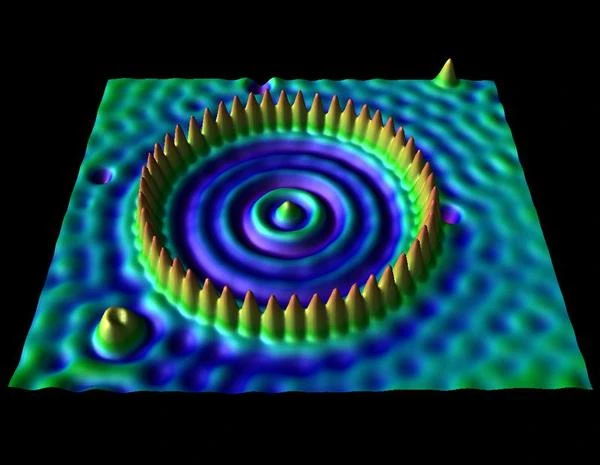
Description of the image: In this image of about 5 millionths of a millimeter (5×10−9 m) you can count 48 iron atoms that behave like waves. These are not atoms but an imagined representation in the visible domain so that the brain can interpret it. This image was created thanks to the measurement of very small electric currents passing through the tip of a Scanning Tunneling Microscope moving above the atoms. Image source: IBM Almaden Visualization Lab
The world of particles such as the electron, photon, proton, atom, is not accessible by our organs of perception, including the brain. No image, no interpretation can represent the reality of the quantum world, even the words of our language are approximate to describe quantum phenomena.
All that can be said and shown of this reality is false, but I will still try to give you an idea of this fundamental concept of quantum physics that is "wave-particle duality" although this term is now obsolete because we should talk about fields.
In quantum mechanics, we often hear that a particle is both a corpuscle and a wave. In reality, it is neither a corpuscle nor a wave but a superposition of all the states of the particle.
The technical definition says this: A quantum particle is a fundamental entity representing a quantization of energy and information localized in space-time, governed by the principles of superposition, entanglement, and indeterminism, and described mathematically by a state function (state vector) in a Hilbert space.
In other words, a quantum particle that is neither a corpuscle nor a wave can be defined as a quantized excitation of a fundamental field described by quantum mechanics and quantum field theories.
Description of the video: Modern interpretation of wave-particle duality from the site Tout est quantique.
N.B.:
How to interpret this experiment? If we want to determine the state of a quantum system, we must observe it, but this observation has the effect of destroying the state in question.
The scale of quantum physics is so small that it is impossible to see a quantum object as we see a wave or a balloon on a beach. The size of a hydrogen atom is 53 pm (53 x 10-12 meters), we can align 10 million atoms on a millimeter.
Young's experiment shows us that when we measure a quantum object, it changes its nature. Sometimes it is a corpuscle, sometimes it is a wave, and moreover, it depends on the measuring device or the observer.
What the Young's slits experiment also tells us is that when the quantum object is free from any environment, it presents itself as a wave. But if the environment (screen, wall, observer, or even air molecules) forces it to interact, the object or rather its energy suddenly reduces to a point and takes on the appearance of a corpuscle.
We notice on the screen that the wavefront does not reduce just anywhere, it reduces where the wave is intense, that is to say on the crests or the troughs. In other words, the probability of reduction is greater at the top and bottom of the wave than on the slopes. It is even zero at the place where the waves are in phase opposition.
If we send the particles one by one, the most astonishing thing is that over a large number of measurements, in the end, despite the reduction of the wave packet, we obtain interference fringes.
An explanation was proposed in 1927 by Max Born (1882 - 1970). The particle is a Probability Wave. This terrible definition shows the difficulty we encounter when we want to talk about quantum objects.
In simpler terms, it is the amplitude of a wave at a given position that predicts the probability that the particle will be found at that position. A high amplitude does not mean that this is where the particle is, but this is where we have the best chance of finding it (after the reduction of the wave packet).
In quantum mechanics, we cannot know if the particle is in a precise place in space, but what is the probability that it is there. It will have a position only if it must interact with the environment; before that, it has no position, it is everywhere and its nature is wave-like. Exactly like a photon emitted by a star. While it has traveled freely for millions of years as a wave, it will die upon reaching your retina with which it will interact.
The equations of quantum mechanics prove to be astonishingly precise as soon as we accept that it is a matter of probability. All the matter that constitutes the universe (stars, planets, trees, you, etc.) is made of atoms and subatomic particles governed by probability and not by certainty.